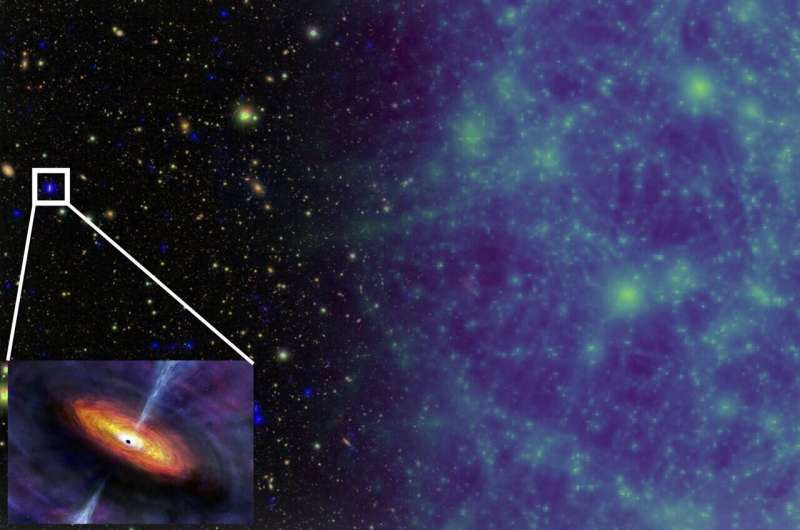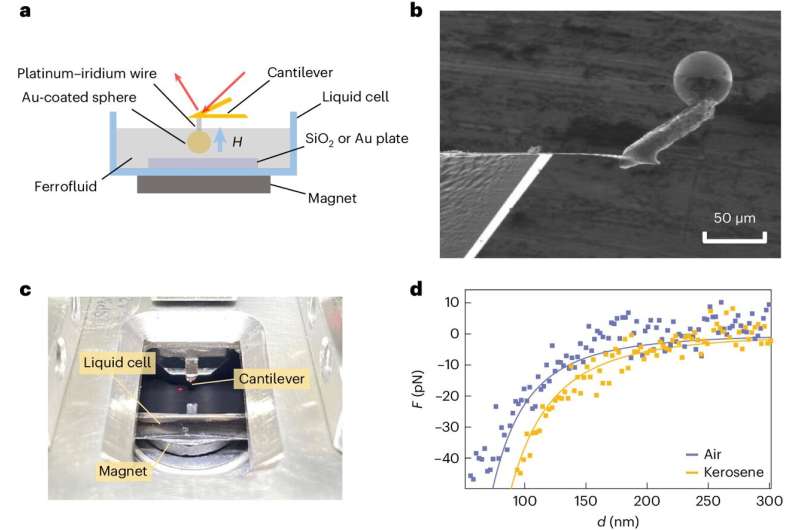Combined X-ray surveys and supercomputer simulations trace 12 billion years of cosmic black hole growth


Researchers have provided the best modeling to date of the growth of supermassive black holes found at the centers of galaxies by combining X-ray observations from the most powerful X-ray objects ever launched into space with supercomputer simulations of accretion. galaxies on the cosmic. history. On the left is an image combining X-ray (blue) and optical (red, green and blue) observations, and on the right is the simulated gas column density from cosmological simulations using IllustrisTNG. The observed X-ray emission is mainly from accreting supermassive black holes, as depicted in the artist’s illustration. The length of the short side of the image covers the same apparent size as the full moon in the sky. Credit: F. Zou (Penn State) et al.; Observations: XMM-SERVS Collaboration; Simulations: TNG Collaboration; Illustration: Nahks TrEhnl (Penn State)
By combining forward X-ray observations with the latest supercomputer simulations of galaxy clustering throughout cosmic history, researchers have provided the best modeling to date of the growth of supermassive black holes found at the centers of galaxies. Using this hybrid approach, a research team led by Penn State astronomers has drawn a complete picture of the growth of black holes over 12 billion years, from the beginning of the universe at about 1.8 billion years to now at 13.8 billion years.
Two papers include the research, one published in The Astrophysical Journal, and an as yet unpublished one to be submitted to the same journal. The results will be presented at the 244th meeting of the American Astronomical Society, held June 9 through June 13 at the Monona Terrace Convention Center in Madison, Wisconsin.
“Supermassive black holes at the centers of galaxies have millions to billions of times the mass of the sun,” said Fan Zou, a Penn State graduate student and first author of the paper. “How do they become such monsters? This is a question that astronomers have studied for decades, but it has been difficult to trace all the ways that black holes can reliably grow.”
Supermassive black holes grow through a combination of two main channels. They consume cold gas from their host galaxy – a process called accretion – and they can merge with other supermassive black holes when the galaxies collide.
“During the process of consuming gas from their host galaxies, black holes emit strong X-rays, and this is the key to tracking their growth by accretion,” said W. Niel Brandt, professor of Astronomy and Astrophysics, head of the Eberly family and professor of physics at Penn State and a leader of the research team. “We measured accretion-driven growth using X-ray sky survey data collected over more than 20 years from three of the most powerful X-ray objects ever launched into space.”
The research team used complementary data from NASA’s Chandra X-ray Observatory, the European Space Agency’s X-ray Multi-Mirror Mission-Newton (XMM-Newton), and the eROSITA telescope of the Max Planck Institute for Extraterrestrial Physics. In total, they measured accretion-driven growth in a sample of 1.3 million galaxies containing over 8,000 rapidly accreting black holes.
“All galaxies and black holes in our sample are very well characterized at multiple wavelengths, with excellent measurements in the infrared, optical, ultraviolet and X-ray bands,” Zou said. “This allows for strong inferences, and the data show that, at all cosmic ages, the most massive galaxies grew their black holes at the fastest rate. With the quality of the data, we were able to quantify this phenomenon of important much better than in the past works.
The second way supermassive black holes grow is through mergers, where two supermassive black holes collide and merge together to form a single, even more massive black hole. To trace the growth from mergers, the team used IllustrisTNG, a suite of supercomputer simulations that model the formation, evolution and merger of galaxies from shortly after the Big Bang to the present day.
“In our hybrid approach, we combine observed accretion with simulated accretion through mergers to reproduce the accretion history of supermassive black holes,” Brandt said. “With this new approach, we believe we have produced the most realistic picture of the growth of supermassive black holes to date.”
The researchers found that in most cases, accretion dominated the growth of black holes. Mergers made significant secondary contributions, especially during the last 5 billion years of cosmic time for the most massive black holes. In general, supermassive black holes of all masses grew much faster when the universe was younger. Because of this, the total number of supermassive black holes was almost fixed 7 billion years ago, while earlier in the universe many new ones continued to appear.
“With our approach, we can track how central black holes in the local universe most likely grow over cosmic time,” Zou said. “As an example, we considered the growth of the supermassive black hole at the center of our Milky Way galaxy, which has a mass of 4 million solar masses. Our results show that our galaxy’s black hole most likely grew relatively late in cosmic time.”
In addition to Zou and Brandt, the research team includes Zhibo Yu, a graduate student at Penn State; Hyungsuk Tak, assistant professor of statistics and astronomy and astrophysics at Penn State; Elena Gallo at the University of Michigan; Bin Luo at Nanjing University in China; Qingling Ni at the Max Planck Institute for Extraterrestrial Physics in Germany; Yongquan Xue at the University of Science and Technology of China; and Guang Yang at the University of Groningen in the Netherlands.
More information:
Fan Zou et al, Mapping the accretion of supermassive black holes as a function of Galaxy stellar mass and redshift, The Astrophysical Journal (2024). DOI: 10.3847/1538-4357/ad27cc
Provided by The Pennsylvania State University
citation: Combined X-ray surveys and supercomputer simulations trace 12 billion years of cosmic black hole growth (2024, June 11) Retrieved June 13, 2024 from https://phys.org/news/2024-06-combined-ray- surveys- supercomputer-simulimet.html
This document is subject to copyright. Except for any fair agreement for study or private research purposes, no part may be reproduced without written permission. The content is provided for informational purposes only.
#Combined #Xray #surveys #supercomputer #simulations #trace #billion #years #cosmic #black #hole #growth
Image Source : phys.org




